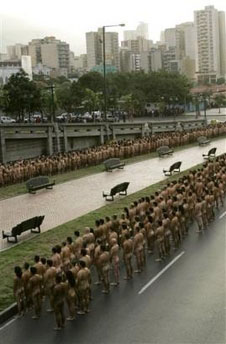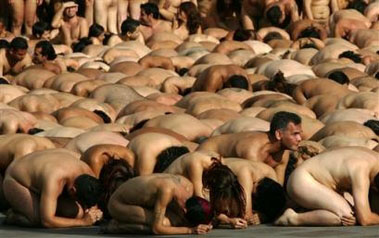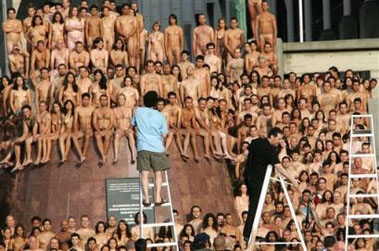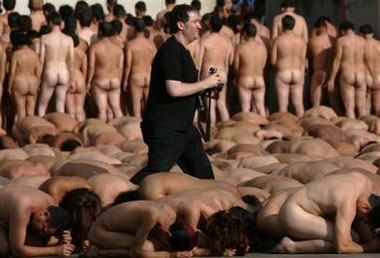
More than 1,500 Venezuelans shed their clothes on a main city avenue Sunday to pose for American photographer Spencer Tunick, forming a human mosaic in front of a national symbol: a statue of independence hero Simon Bolivar.
As Tunick shouted commands through a megaphone, nude people of every shape, size and skin tone gathered on the avenue and stairs in front of the statue just before dawn.

“There are some people over there with clothes, get them out of there!” said Tunick, an artist from Brooklyn, N.Y., who has been documenting groups of nude people in public places around the world since 1992.
For the volunteers, being part of Tunick’s art meant letting go of inhibitions and enduring a two-hour series of sometimes uncomfortable positions on the pavement.

Harold Velasquez, a thin 23-year-old university student, said he was nervous before the 4:30 a.m. event — but felt free while posing.
“I put the lightest clothes I had on this morning because I knew I wouldn’t have them on for long,” a smiling Velasquez said. “There were good vibrations, a good positive energy among all the people involved. I felt liberated.”
The nude subjects posed standing, lying down and on their knees as the warm Caribbean sun emerged on the eastern horizon.
Occasional cheers and movements in the enthusiastic crowd made shooting tough at times, Tunick said.
“It was difficult to work because the people were so exuberant, so it took a little bit longer, but I got what I wanted,” he said after the session.

“The body represents beauty, love and peace. There was a lot of beauty and energy in the people today.”
Tunick took photographs from opposing angles, using buildings with large outside columns as a backdrop on one side and a fork in the wide, palm tree-lined avenue on the other.
The artist, who has been arrested multiple times while shooting in the United States, said he was happy to have darker-skinned subjects. Most Venezuelans are considered mestizo, a mix of Spanish, African and indigenous bloodlines that gives many a brown skin tone.
“I want people of color to pose and come out and participate in my work, so I was very lucky,” the artist said.
Tunick said each volunteer will receive a print of the installation.
“I’m not going to tell my mother about this until I receive the print,” said Josefa Maria Briceno, a 35-year-old surgeon who posed despite having second thoughts.
“She’s going to think I’m crazy.”
STORY STOLEN FROM HERE

